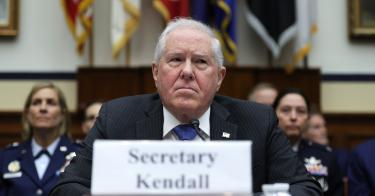Secretary of the Air Force Frank Kendall has signaled an urgent need for the Department of the Air Force to reorganize in response to China's growing military capabilities. Commissioning McKinsey & Company to spearhead a transformative study, the plan involves 24 initiatives aiming to optimize the Air Force for great power competition. Despite the ambitious plan, concerns about the Air Force's current state of readiness loom large. Declines in training standards, promotion processes, and operational capabilities suggest a significant readiness deficit. The reorganization seeks to address readiness, power projection, capabilities development, and personnel management. However, achieving high levels of readiness amidst organizational changes and budget constraints presents a formidable challenge.
In mid-February, Secretary of the Air Force Frank Kendall delivered a blunt warning about China’s 20-year effort to build a military that can deter and defeat the United States: “We are out of time.” Indeed, he added, “we are involved in an enduring competition that could turn to conflict at any given time.”
This obviously makes his plan to reorganize the Department of the Air Force to meet that challenge all the more important. It’s incredibly complex, and while many elements are well thought out, the entire scheme will be impaired without the foundation of readiness.
Let’s start with the plan itself.
>>> In 2024, the U.S. Military Is Weak…and That Should Scare You
Last fall, Kendall commissioned McKinsey & Company, a defense contractor that specializes in organizational change, to lead a study on what transformative steps the Department of the Air Force should take to optimize itself for great power competition.
McKinsey reportedly engaged over 1,500 Airmen and Guardians and used business tools and best practices to frame the service’s reorganization based on what it learned. It conducted progress reviews, exercises, and stakeholder engagements to refine the effort into 24 initiatives within a reorganization that Secretary Kendall framed during his remarks.
Effecting change in a small business unit can take several years to implement, but reorganizing an enterprise the size of the Department of the Air Force is much, much more complicated. Experts in the field estimate that implementing change in such a large organization could take up to six years and involve, in McKinsey’s own words, process and budget disruptions that will generate organizational tension and friction throughout implementation.
I was raised in an Air Force that was organized, postured, and trained to the highest levels of readiness for a face-off with the Soviet Union. As a major, I was part of the initial cadre for the first Air Land Composite Wing in North Carolina and, near the end of my career, I was on the receiving end of some 48 Air Expeditionary Force (AEF) squadrons and elements as an Expeditionary Group Commander during Operations Iraqi and Enduring Freedom.
The transitions and friction associated with the composite wing and AEF reorganizations were disruptive, to put it mildly, but the Air Force weathered it well because its foundational processes and functions were incredibly sound.
The accessions and promotion process were competitive and screened for high levels of talent. Training pipelines held high standards and filled operational units with incredibly competent and competitive airmen. And the service’s operations and maintenance (O&M) budget ensured every squadron and every operational airman therein, received “reps and sets” in the air and on the ground that far exceeded the minimum number required to be considered ready.
Unfortunately, the Air Force is not in the same place today. The drive for efficiencies in the 1990s, coupled with recent moves to inject diversity, equity and inclusion throughout the Air Force, have removed the merit and character screening elements that were once resident in the officer selection process.
Every Air Force captain without legal or ethical issues has been promoted to Major since 2017. In 2021, just 0.27 (point two-seven) percent of flight school candidates were eliminated because of performance, and screening for competence beyond flight school is effectively non-existent. In a war with China, the Air Force could generate just 32 percent of the fighter and bomber capacity it could in 1987. To top it all off, today’s aircrews are getting roughly half the number of sorties that mission-ready pilots received at the height of the Cold War.
The training statistics for aircrews, maintainers, and the professionals beyond the flight line point to an Air Force that has lost focus on mission execution. It is now, in fact, at the lowest state of readiness in its history. Mission capable rates for fighter, bomber, and tanker aircraft have hovered at historic lows throughout Secretary Kendall’s tenure, and the number of sorties, flight hours and mission simulators Air Force aircrews have received would, in no way, would allow a single squadron to be considered mission ready against a peer adversary.
It is hard to imagine a more precarious position to start a major reorganization, but here we are.
Secretary Kendall framed his 24 initiatives within the Department’s four focus areas: readiness, power projection, capabilities development and people. While readiness headlines the four, understanding where it really stands within the list of priorities takes some analysis.
General Dave Allvin, Chief of Staff of the Air Force (CSAF), highlighted readiness in at least two of 15 priorities that Kendall set for the Air Force. The first is to establish the “Mission Ready Command,” which will reside under Airman Development Command (formerly Air Education and Training Command). Unlike its title, Mission Ready Command is not in charge of operational unit readiness. Instead it will give individual Airman the training and skillsets required to transition from one part of the service to another without needing to relearn new systems, and ensure they have the tools required to succeed in the new role.
Evaluating operational readiness was a second readiness priority that focuses on what Allvin referred to as the Service’s reoperating concept: fighting to get out of town, fighting to get into theater, and then fighting to get airborne. The Chief went on to say evaluating that level of readiness would need to involve multiple parts of the Air Force, that it should be part of a unit’s inspection cycle, and that the results and findings of those assessments will be key to the reallocation of assets within service’s limited budget.
While that would imply that evaluating operational readiness was the most important of the 15 Air Force priorities, he went on to admit the service does not actually have a plan, much less the standing structure with which to execute such an evaluation scheme.
The operational readiness inspection (ORI) process in place during the Cold War was incredibly effective at sustaining high levels of readiness. The organization resources, authorities, phases of evaluation, accompanying schemes and schedules, and the reporting structure took years to develop, which impacted virtually every operational and support organization within Pacific Air Forces (PACAF), US Air Forces Europe (USAFE) and what is now Air Combat Command.
But as both Kendall and Allvin conveyed, today’s operating environment is much more complex than the one in play during the Cold War. Building an evaluation scheme that encompasses those complexities will take years to develop and implement. Once it’s in place, there is little doubt its iterations will extend both the duration and the operational dysfunction associated with this reorganization.
>>> What It Takes To Reconstitute the Navy and Win the New Cold War
But the impact the delay will have on service readiness cannot be overstated.
Applying General Alvin’s words about asset allocation, one must assume the Air Force budget will remain relatively constant until that inspection program is in place. In FY 2024, the Department of the Air Force funded the fewest number of flight hours in Service history, furthering a drought in reps and sets that is now seemingly entrenched within the corporate Air Force. While masked by the service’s current method of accessing readiness, the cumulative effects of that drought have undoubtedly impaired the Air Force’s ability to “fight tonight.”
How badly has Air Force readiness degraded over the years? It is hard to say, particularly when senior leaders like General Allvin do little more than brag about an Air Force is the best in the world. He did, however, further the need for this reorganization with an analogy of a championship football team—one that had been optimized to run an outdated formation which would make it harder to win future championships.
A better football analogy would involve the Detroit Lions. In 2020, the Lions could have humiliated any roster a third-world nation could put together. Unfortunately, it didn’t have the foundation, the blocking and tackling skills essential to competing with its peers in the NFL. After a series of losses, the Lion’s leadership installed a new coach who began to rebuild that foundation, but it took Dan Campbell two years to elevate that team’s readiness to a point where the Lions could effectively compete with its peers.
The stakes with China are much, much higher. It will take an exceptionally driven and talented leader at least two years, if not longer, to prepare the Air Force to dominate that looming fight. Let’s hope the Service’s leadership doesn’t wait for a series of losses before it starts that process.
This piece originally appeared in The National Interest https://nationalinterest.org/blog/buzz/us-air-forces-new-mission-beat-china-war-all-costs-209907


